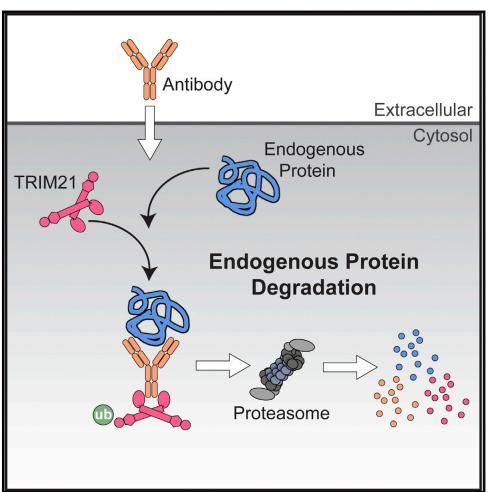Trim Away-A Paradigm Shift in Protein Depletion
Understanding protein function often requires precise depletion methods. Traditional approaches like RNAi or CRISPR are indirect, slow, and ineffective for stable proteins. Trim-Away, a method enabling acute, antibody-mediated degradation of endogenous proteins. By repurposing the immune receptor TRIM21, this technique bridges the gap between genetic tools and dynamic protein analysis.

Trim-Away combines antibodies with TRIM21, an E3 ligase that ubiquitinates antibody-bound targets for proteasomal degradation. The authors validated this system across diverse contexts:
- Speed and Specificity: GFP degradation occurred within minutes in NIH 3T3 cells and oocytes, with no off-target effects. Proteasome inhibition (MG132) blocked degradation, confirming pathway specificity.
- Endogenous Proteins: Eg5 depletion disrupted spindle assembly, while Rec8 degradation in metaphase II eggs caused immediate loss of sister cohesion—phenotypes previously requiring complex genetic models.
- Disease Relevance: Selective degradation of mutant huntingtin underscored Trim-Away's potential for studying pathogenic variants without affecting wild-type proteins.
Trim-Away's adaptability was demonstrated in multiple systems:
- Primary Cells: In transcriptionally silent oocytes and human macrophages, Trim-Away bypassed limitations of RNAi and CRISPR. NLRP3 degradation in macrophages validated its use in immune cells, reducing IL-1β secretion.
- Subcellular Targeting: Membrane-bound, nuclear, and chromatin-associated proteins (e.g., H2B-GFP) were efficiently degraded, though nuclear access required Fc-nanobody fusions.
- Signaling Pathways: Acute mTOR or IκBα depletion modulated mTORC1/2 activity and NF-κB signaling, enabling precise pathway dissection.
Advantages Over Existing Methods
- Speed: Depletion within minutes minimizes compensatory adaptations.
- No Genetic Modification: Avoids artifacts from tagged proteins or prolonged knockdown.
- Broad Applicability: Works in non-dividing cells and across species using commercial antibodies.
Limitations and Considerations
- Antibody Quality: Non-specific antibodies risk off-target degradation (e.g., nuclear pore proteins).
- TRIM21 Levels: Endogenous TRIM21 may suffice in some cells, but overexpression or exogenous delivery is often needed.
- Complex Stability: Degrading one subunit (e.g., mTOR) can destabilize entire complexes (e.g., mTORC1/2).
Future Directions
Trim-Away's potential extends beyond basic research:
- Therapeutics: Targeting disease-causing proteins (e.g., tau in neurodegeneration) could offer new treatment strategies.
- Precision Tools: Fc-nanobodies or compartment-specific TRIM21 variants could enhance spatial control.
- High-Throughput Screens: Rapid depletion enables systematic analysis of protein networks.
Trim-Away's speed, versatility, and applicability to primary cells make it indispensable for studying dynamic biological processes and developing targeted therapies. As antibody libraries and delivery methods advance, Trim-Away promises to illuminate previously intractable questions in cell biology and disease mechanisms.
Reference
- Clift D, McEwan WA, Labzin LI, Konieczny V, Mogessie B, James LC, Schuh M. A Method for the Acute and Rapid Degradation of Endogenous Proteins. Cell. 2017 Dec 14;171(7):1692-1706.e18. doi: 10.1016/j.cell.2017.10.033. Epub 2017 Nov 16. PMID: 29153837; PMCID: PMC5733393.
Contact us or send an email at for project quotations and more detailed information.
Quick Links
-

Papers’ PMID to Obtain Coupon
Submit Now -

Refer Friends & New Lab Start-up Promotions

